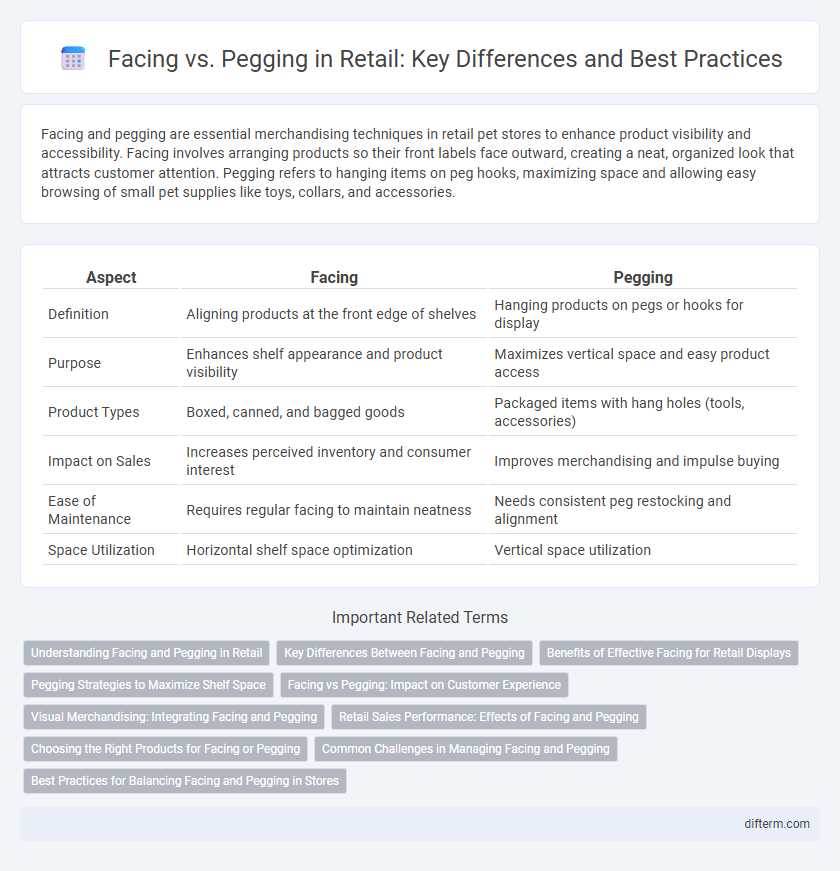Facing and pegging are essential merchandising techniques in retail pet stores to enhance product visibility and accessibility. Facing involves arranging products so their front labels face outward, creating a neat, organized look that attracts customer attention. Pegging refers to hanging items on peg hooks, maximizing space and allowing easy browsing of small pet supplies like toys, collars, and accessories.
Table of Comparison
| Aspect | Facing | Pegging |
|---|---|---|
| Definition | Aligning products at the front edge of shelves | Hanging products on pegs or hooks for display |
| Purpose | Enhances shelf appearance and product visibility | Maximizes vertical space and easy product access |
| Product Types | Boxed, canned, and bagged goods | Packaged items with hang holes (tools, accessories) |
| Impact on Sales | Increases perceived inventory and consumer interest | Improves merchandising and impulse buying |
| Ease of Maintenance | Requires regular facing to maintain neatness | Needs consistent peg restocking and alignment |
| Space Utilization | Horizontal shelf space optimization | Vertical space utilization |
Understanding Facing and Pegging in Retail
Facing in retail involves arranging products on shelves so that labels face forward, enhancing visual appeal and making items easier for customers to find. Pegging refers to hanging products on peg hooks, maximizing vertical space and improving accessibility for smaller packaged goods. Both techniques optimize shelf presentation and influence purchasing behavior by increasing product visibility and organization.
Key Differences Between Facing and Pegging
Facing involves arranging products by pulling them forward to create a neat, full display on shelves, improving product visibility and enhancing customer appeal. Pegging refers to hanging products on hooks or pegs, optimizing vertical space and facilitating easy access for small, packaged items. The key differences lie in their application: facing is best for bulky or packaged goods requiring full shelf visibility, while pegging suits lightweight, hangable products, maximizing limited retail space.
Benefits of Effective Facing for Retail Displays
Effective facing in retail displays maximizes product visibility by keeping items neatly organized and front-facing, which directly enhances customer appeal and increases purchase likelihood. Consistent facing reduces restocking time and labor costs by making inventory levels easier to monitor and maintain. High-impact store presentation through proper facing drives increased sales and promotes brand consistency across retail locations.
Pegging Strategies to Maximize Shelf Space
Pegging strategies optimize shelf space by positioning products on hooks or pegs to enhance visibility and accessibility, driving impulse purchases and increasing turnover rates. Strategic pegging leverages vertical and horizontal space, allowing retailers to display a higher volume of items in a compact area, maximizing shelf efficiency. Effective pegging also aids inventory management by facilitating easier restocking and maintaining organized product presentation, which improves the overall shopping experience.
Facing vs Pegging: Impact on Customer Experience
Facing enhances customer experience by ensuring products are neatly organized and fully visible, making it easier for shoppers to find items quickly. Pegging, while useful for displaying individual products on hooks, often results in a cluttered appearance that can hinder product visibility and reduce shelf appeal. Effective facing increases product accessibility and attractiveness, directly influencing customer satisfaction and purchase decisions.
Visual Merchandising: Integrating Facing and Pegging
Effective visual merchandising integrates facing and pegging techniques to maximize product visibility and appeal on retail displays. Facing involves arranging products neatly at the front edge of shelves to create an organized, full appearance, while pegging uses hooks to hang items, enhancing accessibility and space utilization. Combining both methods improves customer engagement by showcasing products attractively and encouraging interaction, ultimately boosting sales performance.
Retail Sales Performance: Effects of Facing and Pegging
Facing improves Retail Sales Performance by enhancing product visibility and creating a more organized shelf appearance, which attracts customer attention and encourages purchases. Pegging increases stock capacity and accessibility but may reduce perceived product prominence if overused or cluttered. Effective retail merchandising balances facing and pegging strategies to optimize shelf space, maximize product exposure, and drive higher sales conversions.
Choosing the Right Products for Facing or Pegging
Choosing the right products for facing or pegging depends on factors like product size, packaging, and shelf space. Small, lightweight items with uniform packaging are ideal for pegging to maximize visibility and ease of access. Bulkier or irregularly shaped products benefit from facing to maintain an organized shelf presentation and enhance brand visibility.
Common Challenges in Managing Facing and Pegging
Retailers often face inventory inconsistencies and misaligned product displays when managing facing and pegging, leading to reduced shelf appeal and customer satisfaction. Ensuring accurate facing counts is challenging due to frequent product movement and staff errors, while pegging demands precise SKU placement to optimize visibility and sales. Inefficient coordination between facing and pegging routines can result in stockouts or overstocking, impacting overall store performance and profitability.
Best Practices for Balancing Facing and Pegging in Stores
Optimizing shelf presentation requires a strategic balance between facing and pegging to enhance product visibility and accessibility. Ensuring adequate facings improves customer perception of stock availability, while pegging maintains organized spacing and prevents overcrowding on shelves. Regular audits and data-driven adjustments help retailers maximize sales by aligning shelf layouts with shopper behavior and inventory levels.
Facing vs Pegging Infographic

 difterm.com
difterm.com